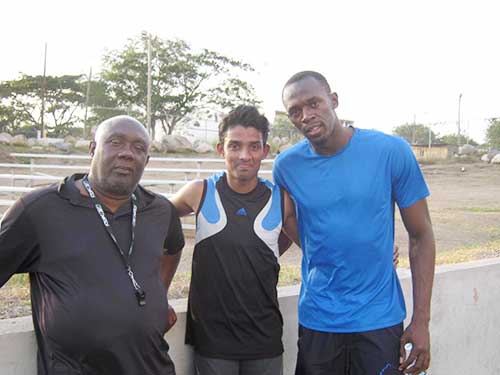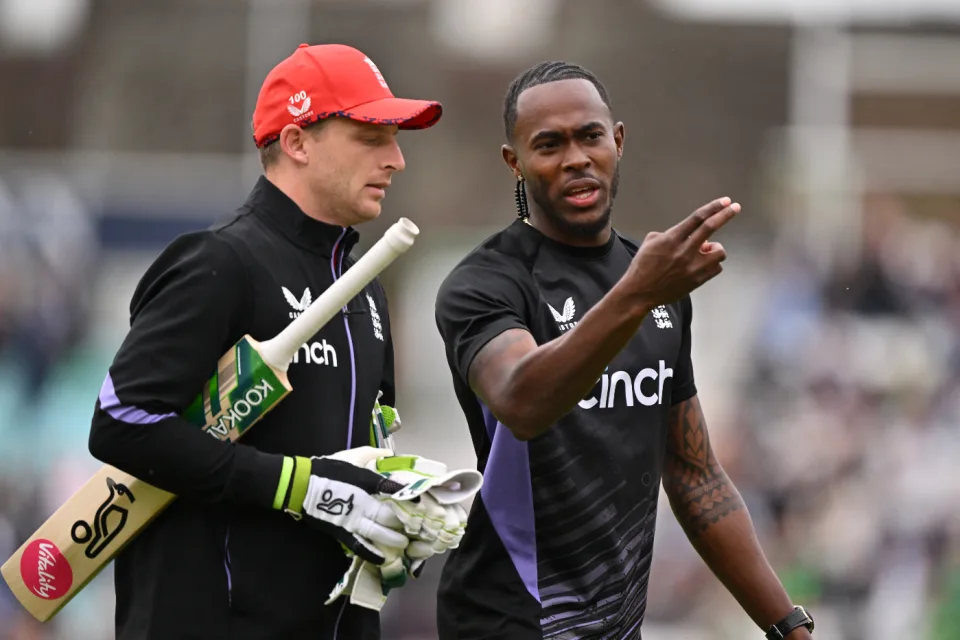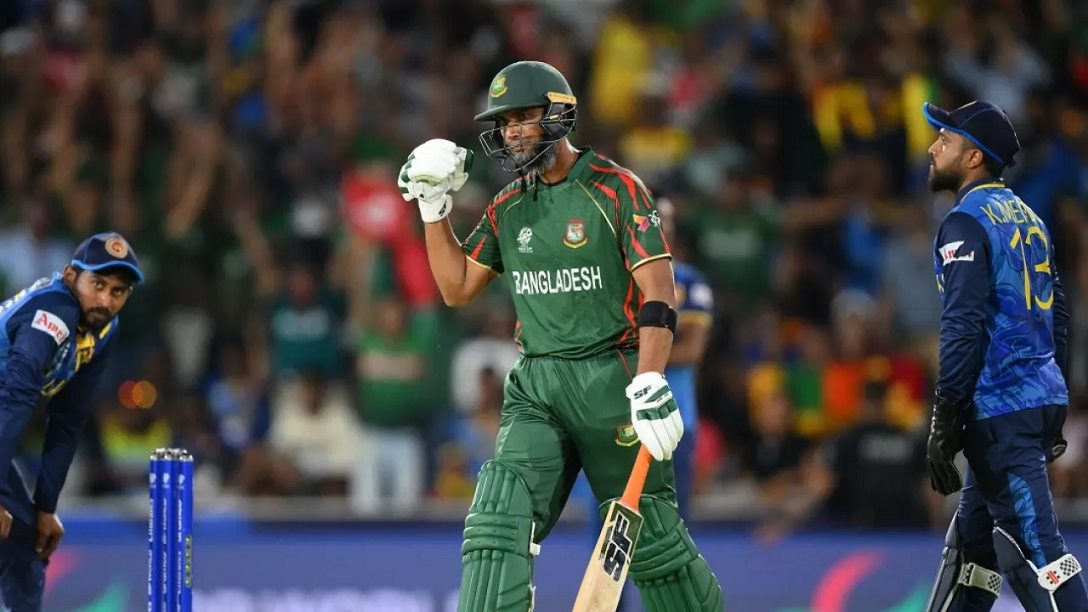Sports
Sprinting with giants yet feeling dwarfish

For two years Ambepitiya had the rare privilege of having sprint king Usain Bolt and his closest contender to world titles Yohan Blake as his training partners but what became of his long cherished ambitions after heavy loads of training in Jamaica is something that should be seriously studied by those who propose foreign training for Sri Lankan athletes. Shehan Ambepitiya flanked by Usain Bolt and Glean Mills.
Foreign training for local athletes
Story of a Lankan youth who trained alongside Bolt
by Reemus Fernando
Sprinter Shehan Ambepitiya had the privilege of being trained by probably the best sprint coach in Sri Lanka. He had bagged several coveted international medals by the time he turned 20. By 2010 he was just three milliseconds behind the Olympic qualifying mark for 100 metres (judging by the 2008 qualifying standards) when the highly excited National Olympic Committee provided him with an IOC scholarship to be trained by Glean Mills alongside world record holder Usain Bolt. For two years Ambepitiya had the rare privilege of having sprint king Usain Bolt and his closest contender to world titles Yohan Blake as his training partners but what became of his long cherished ambitions after heavy loads of training in Jamaica is something that should be seriously studied by those who fancy foreign training for Sri Lankan athletes.
There are many Sri Lankan track and field athletes who benefitted from foreign training and reached Olympic qualifying standards and international medal winning standards. Olympians from S. L. B. Rosa and Nagalingam Ethirveerasingam to Manjula Kumara, who had US University scholarships and from Olympic medalist Susanthika Jayasinghe to Asian Championship medalist Sachith Maduranga, high performance training overseas had a huge positive impact on their sporting careers.
But from sprinters Ambepitiya to Chandrika Subashini to long jumper Sampath Dissanayake it was a different story as they struggled to reach their personal best after undergoing training meant for track and field’s super stars. Current sprinter Himasha Eshan, who also had a training stint in Jamaica also had to face a similar predicament and remodel his training plans after returning from Jamaica.
“It was a good experience to train alongside the likes of Bolt and Blake but I never ran closer to my personal best after training in Jamaica,” said Shehan Ambepitiya in an interview with The Island on Monday.
“I was following the same training schedule Bolt and Blake was following. It was not an individualised training plan. Obviously, the focus during training was on Bolt.”
By 2008, Ambepitiya had burst like a rocket into international scene under Sunil Gunawardena’s guidance. He had shown lot of promise at a very young age that he was looked up to as a future medal prospect at senior World level. That year he became the first Sri Lankan male athlete to feature in a final of a World Athletics event when he finished seventh in the 100 metres final at the U20 World Championships. The same year, the former Gateway College and President’s College, Rajagiriya, athlete won three gold medals at the Commonwealth Youth Games in India.
In 2010, Ambepitiya clocked his personal best of 10.31 seconds as he won gold to become South Asia’s fastest man. Athletics had unearthed a wonderful talent. Something had to be done.
Neither the NOC nor the authorities who influenced him to take up the IOC scholarship to be trained in Jamaica meant bad for Ambepitiya. But Sunil Gunawardena, the person who had the knowledge of the athlete was not consulted. Would it have made a difference if had they consulted Gunawardena?
Ambepitiya said: “Sir [Sunil} did not give his consent. At that time I also did not understand why he was not willing to send me for training in Jamaica.”
When he returned from Jamaica, Ambepitiya had a nagging hamstring injury to cope up with and those who were expecting miracles to happen wondered why he had not qualified for the 2012 London Olympics.
“Everything was different in Jamaica from food to training. Sunil Sir was yet to introduce me to lift heavy weights in training here. In Jamaica, I was introduced to them without any evaluation.
But when I returned I was far behind my personal best. It took years before I could run below 10.50 seconds again.”
Despite failing to improve his personal best, Ambepitiya continued training under Gunawardena with a lot of commitment for years and was a part of the team that established the current national record in the men’s 4×100 metres at the Commonwealth Games in 2018.
Asked for his views on foreign training for local athletes, Ambepitiya opined that he would not recommend it for track and field athletes.
Sports Minister Namal Rajapaksa has highlighted the need to provide foreign training for country’s best athletes. It has been reported that the best athletes selected from this year’s competitions would be sent abroad for training. It is doubtful whether there would be competitions this year due to the COVID-19 pandemic. But when the competitions are held and future prospects emerge it would be advisable to weigh the pros and cons of overseas training carefully. Foreign training which is perfect for one may not be so for another as in the case of Ambepitiya.
Sports
England face Australia in the battle of champions

The first truly heavyweight clash of this expanded T20 World Cup format comes freighted with both history and subplots. A rematch of the 2010 World T20 final at Kensington Oval, the match pits Jos Buttler’s defending champions – who are aiming to become the first team to retain the trophy – against the Australian winning machine, victors at the 2021 edition and current world title-holders in Test and ODI cricket. And that’s before you throw in the Ashes for afters.
Already there is added pressure on England, after the rain in Bridgetown led to a share of the points in their opener against Scotland (and that having conceded 90 runs from 10 overs without taking a wicket in a tepid bowling display). Lose to their oldest rivals and it will leave their Super 8 prospects open to being waylaid by the perils of net run-rate calculations, or worse.
The Scotland match was the third abandonment in five suffered by England, after a rain-affected home series against Pakistan, which has clearly hampered their readiness for this campaign after almost six months without playing T20 together. It does not take much for a side to click in this format – and England looked in decent shape when they did get on the field against Pakistan – but Buttler will be anxious for things to go their way on Saturday, if only to avoid further questions referencing the team’s disastrous ODI World Cup defence last year.
Australia, under the laidback leadership of Mitchell Marsh would love nothing more than to add to the English sense of jeopardy – having helped bundle them out of the tournament in India on the way to taking the crown. Their head to head record is less impressive in T20 however, with England having won six of the last seven completed encounters, as well as that 2010 final.
Despite a wobble with the bat, Australia avoided mishap against Oman earlier in the week, the experience of David Warner and Marcus Stoinis shining through in difficult batting conditions. Surfaces in the Caribbean – not to mention those games staged in the USA – have already had teams scratching their heads; rather than the “slug-fest” England had prepared for, following a high-scoring tour of the Caribbean in December, it looks as if boxing smart may be the way to go.
Speaking of Warner, this could be the last time he faces up against England in national colours – and another match-winning contribution would likely reduce the chances of them meeting again in the knockouts. On the other side of the card is Jofra Archer, fresh from an emotional maiden outing at Kensington Oval and ready to take on Australia for the first time in any format since 2020. Can Mark Wood fire up England’s campaign, as he did during last summer’s Ashes? Will Pat Cummins be back to harass the old enemy once again? Seconds out, it’s almost time to rumble.
Cummins is set to return after being rested for the Oman game, which saw Mitchell Starc leave the field with cramp. Starc is understood to be fine and could keep his place – which would likely see Nathan Ellis miss out. Marsh is still not fit to bowl, with Australia likely to continue with the allrounder combination of Stoinis and Maxwell to give them cover.
Australia (probable XI): David Warner, Travis Head, Mitchell Marsh (capt), Glenn Maxwell, Marcus Stoinis, Josh Inglis (wk), Tim David, Pat Cummins, Nathan Ellis/Mitchell Starc, Adam Zampa, Josh Hazlewood
The one change England may consider is Reece Topley coming in for Wood, with the expectation that there will be some rotation among the seamers through the course of the tournament.
England (probable XI): Phil Salt, Jos Buttler (capt & wk), Will Jacks, Jonny Bairstow, Harry Brook, Liam Livingstone, Moeen Ali, Chris Jordan, Jofra Archer, Adil Rashid, Reece Topley/Mark Wood
[Cricinfo]
Sports
South Africa up against their bogey team in batter-unfriendly New York

Once is coincidence, twice is a clue, and three times is proof.
To paraphrase Agatha Christie, that is the narrative around South Africa’s meeting with Netherlands at this T20 World Cup.
The Dutch beat South Africa at the 2022 tournament and ended their semi-final hopes in a match where South Africa appeared to be sleep walking, and then beat them again at the 2023 ODI World Cup, where they exposed South Africa’s vulnerability in the chase. If they to do the treble, not only will Netherlands take the lead in Group D, but they will offer conclusive evidence of the threat they pose to Full Members, especially South Africa.
Of course, it will take some doing after South Africa’s opening performance against Sri Lanka, where they reduced their opposition to their lowest T20I total and chased it down in fairly straightforward fashion thanks to the most stable middle-order of their white-ball era. In Aiden Markram, Tristan Stubbs, Heinrich Klaasen and David Miller, South Africa have bankers and big-hitters and, for this match, they also have the advantage of experience. They’ve already played at Eisenhower Park, and have first-hand knowledge that run-scoring doesn’t come easily;Klassen said they are prepared to use their “cricket brains” and play “smarter cricket”.
But the conditions could be good news for Netherlands, who are not naturally a line-up of big hitters and build their innings on a foundation of turning ones into twos. In other words, they tend to take a slightly more conservative approach to batting, which may work well here, but they’ll be wary of the uneven bounce of the surface and will have to come up with plans to counterattack especially against South Africa’s seamers. Their own bowlers were exemplary in Dallas and will look to build on that performance against a line-up that will likely be more proactive than Nepal’s, but who they have managed to keep quiet not once, but twice in the past. Third time’s the charm, they say.
Anrich Nortje’s stunning return to form against Sri Lanka means South Africa may not have to tinker with the bowling combination, and Gerald Coetzee and Tabraiz Shamsi may have to wait their turns to get a game. The batting line-up should be unchanged, with no space for Ryan Rickelton yet.
South Africa: Quinton de Kock (wk), Reeza Hendricks, Aiden Markam, Tristan Stubbs, Heinrich Klaasen (wk), David Miller, Marco Jansen, Keshav Maharaj, Kagiso Rabada, Ottneil Baartman, Anrich Nortje
Conditions in New York may tempt Netherlands to include an extra seamer and they have Kyle Klein in their squad. But it could come at the expense of a shortened batting line-up and they may not want to risk that.
Netherlands: Michael Levitt, Max O’Dowd, Vikramjit Singh, Sybrand Engelbrecht, Scott Edwards (capt, wk), Bas de Leede, Teja Nidamanuru, Logan van Beek, Tim Pringle, Paul van Meekeren, Vivian Kingma
[Cricinfo]
Latest News
Mustafizur, Rishad, Hridoy dazzle in Bangladesh’s tight two-wicket win over Sri Lanka

Nuwan Thushara’s last over brought Sri Lanka screaming back into the match,as he first bowled Rishad Hossain, and then nailed Taskin Ahmed in front of the stumps with a pinpoint swinging yorker. This left Bangladesh eight wickets down, with 12 runs still to get.
However, the experienced Mahmudullah was at the crease for Bangladesh, and despite some further nervy moments, pushed Bangladesh across the line off the last ball of the 19th over.
But this was a match chiefly decided by Bangladesh’s own outstanding bowling. Mustafizur Rahman was the best among them, using shorter lengths and his cutters efficiently, to claim figures of 3 for 17. Rishad Hossain’s three-for through the middle overs also kept Sri Lanka quiet.
Mustafizur was instrumental in Sri Lanka’s downward spiral through the middle overs, which culminated in a crash-and-burn end. Ultimately, their inability to find boundaries, or even rotate strike against good Bangladesh bowling resulted in their downfall. A score of 125 for 9 always seemed poor on a decent pitch, even if their bowlers made a match of it in the end.
Brief scores:
Bangladesh 125 for 8 in 19 overs (Towhid Hridoy 40, Litton Das 36; Dhanajaya de Silva 1-11, Nuwan Thushara 4-18, Wanidu Hasaranga 2-32, Matheesha Pathirana 1-27) beat Sri Lanka124 for 9 in 20 overs (Pathum Nissanka 47, Dhananjaya de Silva 21; Tanzim Hasan Sakib 1-24, Taskin Ahmed 2-25, Mustafizur Rahman 3-17, Rishad Hossain 3-22) by two wickets
[Cricinfo]





















